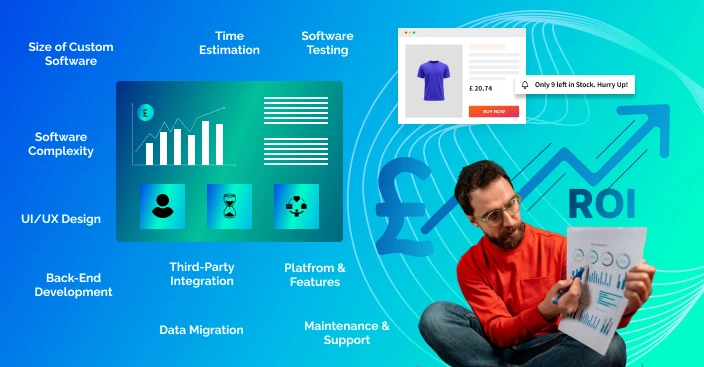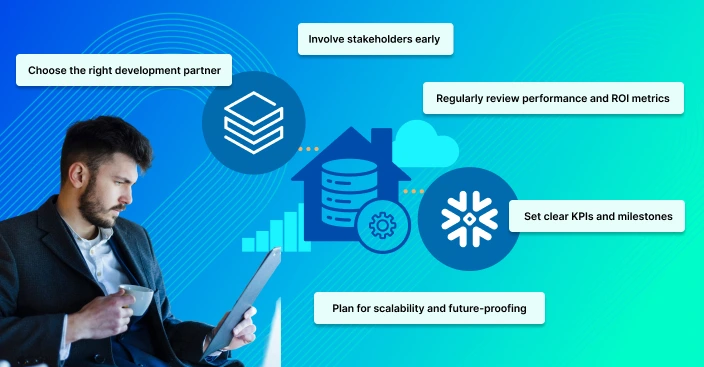Custom Software Costs vs ROI: A Real-Life Handbook for UK Decision-Makers

Table of Contents
In a more competitive online economy, custom software is turning into an amazing business asset for companies that wish to streamline operations, improve customer experiences, and compete successfully.
In the UK, where companies compete in one of the most diverse and dynamic markets, decision-makers must calculate whether it’s worth investing money in custom software.
This article is meant to educate UK business leaders so that they can make an informed decision by learning about the investment, the potential ROI, and how to drive custom software development strategically.
Why UK Businesses Are Turning Heads Towards Custom Software
UK companies are always under pressure to innovate and be at the forefront. Off-the-shelf software is generally insufficient in addressing specific operational problems; hence, the majority of companies resort to bespoke solutions.
Custom software allows for complete alignment with business processes. A Birmingham manufacturer, for example, might need a system which not only monitors stock levels in real-time but also makes sure that they are regulatory compliant, which a generic solution cannot offer.
With the help of a custom platform, the UK brands can enjoy seamless integration with their legacy system. It will be designed by aligning with the regulatory compliance of the country to ensure they get a higher success rate.
Secondly, companies that are set to digitalise their operations in the wake of Brexit are counting on solutions capable of adapting to a dynamic regulatory environment, taxation standards, and trade practices. Custom software can offer such adaptability and foresight.
Factors Affecting the Final Costing of Custom Software Development In The UK
Project Scope and Complexity
The greater and more complicated your business requirements are, the pricier the development will become.
The cost of an enterprise resource planning (ERP) solution could be significantly lower than that of a basic mobile app for internal business use.
For example, A supply chain management system will need integrations, current data updates, complex analytics, and so forth, whereas a simple tracking time application could only need a limited range of features and user roles.
Technology Stack and Tools
The chosen frameworks and technologies also determine cost. Commonly used frameworks like React, Angular, or Laravel may be a little cheaper, subject to the availability of coders.
However, enterprise frameworks with high-level security features, such as Java or .NET, can be more costly due to their license fees and experts cost.
Development Team Location
Hiring UK developers entails better compensation rates. UK developers are paid between £50-£150 per hour, subject to experience.
Hybrid models are embraced by other companies by hiring offshore or nearshore teams to reduce costs, but not quality.
Timelines and Delivery Models
An expedited project would cost more since it would require extra funds and overtime. The budgets must account for continuous input from stakeholders, testing, and validation when adopting rapid delivery models, which may involve iterative releases.
Hidden and Recurring Costs
Apart from these main factors, there are also a few more things that impact the costing. Let’s explore them below:
External Software Licensing Fees
Some software demands for additional functionally and that can be done by the external providers. Even if the software is built in-house, you might need to integrate few platform like payment gateways, CRM or analytics suits.
Such services generally have periodic charges based on the volume of usage or the user base. Over time, these charges add significantly to your total software expenses.
Hosting and Cloud Infrastructure
Custom applications need reliable hosting platforms to work efficiently. With AWS, Microsoft Azure, or dedicated servers, you are charged for bandwidth, storage of data, server upkeep, backups, and uptime warranty.
Cloud computing infrastructure is a continuous and sometimes variable expense that is frequently billed on an ongoing schedule and dependent on input.
Upkeep and Modifications
Software needs to be updated after implementation in order to fix errors, improve productivity, and stay competitive with new technology. Additionally, updates are essential for fixing security flaws.

These activities have recurring needs and must be maintained by developers and can consume 15–25% of the original development expense annually, which renders them a significant cost consideration.
Employee Training and Change Management
New software implementation demands that workers modify their processes and functionalities. Training programs, manuals, inducting employees, and downtime in productivity incur costs.
Further, organisational change management like realigning teams, amending SOPs, and managing resistance also involves effort and preparation, impacting your internal budgets and timelines.
Data Migration and Testing
The data migration is a crucial process to move your data without losing or corrupting it. This process demands a structured approach associated with formatting, cleaning, and validating the data.
So does rigorous testing across users and machines, usually involving QA engineers, both adding to the timeline and cost escalation.
All these factors are generally not part of the initial development cost price tag; they must be factored into the overall cost of ownership.
Measuring ROI Outside the Balance Sheet
ROI for custom software needs to be seen not just as profit, but as total business value. ROI can take on a myriad of forms, ranging from cost savings and time savings to increased customer satisfaction.
Operational Efficiency and Time Savings
Significant time reduction for an employee is a major benefit of custom software development when it comes to tasks like mundane ones.
For example, automating those administrative tasks can increase opportunities for an HR employee to focus on value-added ones.
The savings accumulate over time; hence, those would translate to higher employee satisfaction and lower operating costs.
Better Customer Experience
A company can use customised customer portals, targeted communications, and smooth service delivery to give clients the maximum possible customer experience.
For example, an insurance or finance service business would see increased customer retention and referral rates.
Competitive Advantage
Custom software can be made with features and workflows that are specifically designed for your brands and make it more difficult for your competitors.
For example, an internal reservation system can offer more flexibility and dynamic pricing than competitors who rely on templates.
Scalability and Futureproofing
Custom software can always be enhanced as you go with your business growth, while hidden issues with maintenance and decreasing sustainability cost become the major problem in off-the-shelf products that one day are outdated or just will not be good enough.
One can add features, expand user roles, and integrate new tools without the need to rewrite an entire system.
Higher Security and Compliance
In the UK, businesses must adhere to many legal requirements, including GDPR and PCI-DSS.. Custom software provides more control over the storage, access, and security of data, hence minimising threats of breach or fines.
Calculating ROI: A Practical Approach
ROI calculation involves both qualitative and quantitative analysis.
Here is a basic formula:
ROI (%) = [(Net Gain from Investment – Cost of Investment) / Cost of Investment] x 100
We take an example from an actual scenario. A Leeds-based logistics company spends £60,000 to develop a customised fleet management app.
Post implementation, they experience:
- Labour cost savings of £20,000 annually
- Enhanced delivery times are worth £15,000 in additional revenues
- Reduced compliance fines of £5,000
The break-even is 1.5 years with a cumulative benefit of £40,000 annually. Within five years, the total return on investment is £200,000, equating to an ROI of over 233%.
When to Invest in Custom Software
Custom software is not needed by all businesses. The key lies in understanding when it is more required than desirable.
- You Should Consider Custom Software If:
- Your processes are highly specialised or evolving rapidly.
- You’re using multiple off-the-shelf tools that don’t communicate well.
- Compliance and data privacy are critical.
- Your current software limits scalability.
For example, a healthcare provider dealing with patient confidentiality and compliance with the NHS framework would benefit greatly from a custom solution over a general CRM.
Situations Where It May Not Be Ideal
If you’re a start-up at an early stage or have fairly standard processes, off-the-shelf packages should be sufficient.
Similarly, if you lack the in-house capacity to provide support for customised software after it has been installed, the total cost of ownership might outweigh the benefit.
Maximising ROI: Best Practices for UK Businesses
Start Small with MVP
A Minimum Viable Product allows you to validate your assumptions and test your idea before making investments at scale. This reduces risk and provides user feedback early on.
Involve Users Early and Often
End-user input guarantees the software is usable, intuitive, and really resolves the issues it was designed to address. A user-friendly CRM that your sales force will embrace easily will yield much higher ROI than a system with lots of features they won’t use due to it being too difficult to navigate.

Select the Right Development Partner
Go for UK-based companies with a successful track record, transparent contracts, and industry-specialist expertise. A good partner will assist you as a consultant, helping you to create the product, not just build it.
Put Long-Term Goals First
Set KPI’s that are connected with your business goals, apart from focusing only on development timetables. Assess software performance in terms of revenue enhancement, workflow efficiency, regulation, or defection reduction.
Emerging Trends that Shape Custom Software in the UK
Several trends drive the future of custom software development in the UK:
Cloud-Native and Headless Architectures
They deliver elasticity and strength.Companies can easily scale by making changes to their front-end without affecting back-end operations.
Low-Code and No-Code
With the help of low-code or no-code it’s possible to make internal team manage their website without tech expertise. They can update the website without depending on engineers or tech team, facilitate rapid prototyping.
Automation and AI
AI has majorly transformed the website experience, it;s continuously changing the buyers shopping experience. With the implementation of chatbots, predictive analytics, and machine learning capabilities, the custom software can be booming towards excellence. It will furthner boost the customer delight and decision-making.
AI and Automation
Custom software choosing AI features majorly to ensure a seamless experience. It helps to gow the customer happiness, help them to make decisions faster,and simplify the commnucations with chatbot, predictive analytics, and machine learning capabilities.
Success Story
Ocado
Ocado, the UK supermarket number one on the internet, was crumbling under pressure to grow quickly without losing the pace or accuracy of the process.
The company found off-the-shelf warehouse management systems unable to meet their ambitious automation plans or provide the much-needed flexibility to deal with skyrocketing customer demand.
What kept the company going in the developing phase was a long-term investment by Ocado in the creation of a fully bespoke platform for warehouse automation underpinned by proprietary software and AI-enabled robotics.
Today, the tailor-made system coordinatates the activities of more than 3,000 robots inside its own fulfillment centres to facilitate picking, packing, and logistics for delivery.
The results were revolutionary. Ocado increased fulfilment effectiveness by 50%, saved on picking time by 75%, and processes more than 300,000 customer orders every week with the touch of a human finger.
Besides the operational improvements, Ocado capitalised on its investment by commercialising the platform globally, having tied up with such mega global retailers as Kroger in the United States.
While their initial investment has exceeded £100 million, the long-term return on investment includes operational savings costs, improved customer satisfaction, and a new source of revenue through licensing of the platform.
Babylon Health
Babylon Health was one of the first companies to enter the UK healthcare space; it started by building a bespoke telemedicine platform that would relieve some pressure off the National Health Service.
To deliver digitally driven care, patients would receive remote diagnoses and consultations, and they would connect with flexible services. As a result, the firm created a mobile application that can be connected with digital prescriptions.
As a benefit, the medical records can be securely accessed, the AI implementation has made it easy to check the symptoms, and ensure real-time online interactions with doctors.
The customised approach resulted in almost 30% fewer in-person GP visits, freeing up NHS resources for more urgent issues.
Having attained more than 1.5 million users in the UK and expanding successfully into other markets, Babylon acquired more than $600 million in global funding.
The company’s own platform not only gave better access to medical care and patient experience but also showed a solid ROI in market valuation, operating efficiency, and impact on the provision of public health in the UK.
Conclusion
Custom software solutions is not a one-size-fits-all option, but when well-thought-out and executed, it has the potential to transform UK businesses.
From optimising operation efficiency to data protection, and from enhancing customer experience to enabling long-term scalability, the benefits are extensive and long-term.
Upfront cost may be higher, but linked to business goals, return on investment is not just measurable in profit margin, but also in business agility, robustness, and expansion.
As a UK decision-maker, looking at bespoke software from end-to-end is at the heart of making a wise, forward-thinking investment. Connect with a software development service provider for better implementation for the UK market.
FAQs
 How soon could one get money back from investment in custom software?
How soon could one get money back from investment in custom software?
It is generally accepted that within 12 to 24 months the payoff is realised, depending on the intricacies of the project and on the business objectives.
 What will be the approx cost of software development in UK?
What will be the approx cost of software development in UK?
The costs depends on the need of features, the size of the development team, and project size.
 How long does custom software development normally last in the UK?
How long does custom software development normally last in the UK?
The general custom software development times range from 3 to 9 months. However, it can be more or less based on the requirements of the project, and complexity.
 Can custom software development boost effectiveness and reduce long-term operational costs?
Can custom software development boost effectiveness and reduce long-term operational costs?
Yes; in the sense that it automates workflows and cancels operations that lead to error and long-term operational costs.
 Which KPIs must be measured to properly evaluate software ROI?
Which KPIs must be measured to properly evaluate software ROI?
Cost savings, time savings, error reductions, customer retention, revenue and similar numbers should be measured.
These are important when evaluating the ROI of both traditional software and mobile application development in the UK.
 Is custom software more ROI-effective than a SaaS subscription in the long run?
Is custom software more ROI-effective than a SaaS subscription in the long run?
Yes, especially for developing and large companies, custom software tends to yield greater ROI and is more scalable in the long run.



